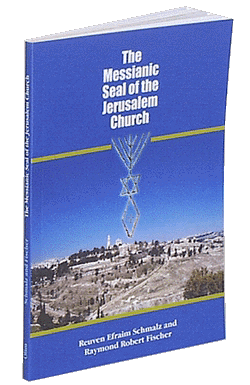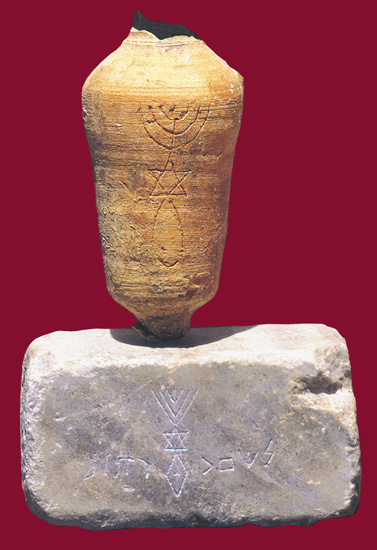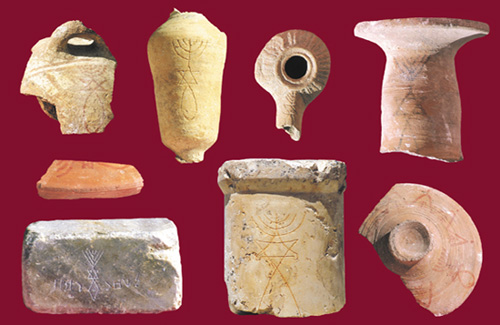|
 The
Messianic Seal of the Jerusalem Church - Suppressed since 135CE
by the Orthodox Rabbis! - Buried for millennia by the Roman Catholic
Church! - Key to understanding the Dead Sea Scrolls! The
Messianic Seal of the Jerusalem Church - Suppressed since 135CE
by the Orthodox Rabbis! - Buried for millennia by the Roman Catholic
Church! - Key to understanding the Dead Sea Scrolls!
Resurrected after nearly 2,000 years of
silence, from an ancient grotto adjacent to the very first Christian
Church on Mount Zion!
Scribed and drawn on ceremonial artifacts
most likely used by Pastor James the Just, the brother of Jesus
and the Twelve Apostles!
The ancient three part symbol: Menorah,
Star of David and Fish, once again proclaims to the world the
pervasive Jewishness of Jesus Christ and the decidedly Jewish
foundation and roots of the Church founded in His name.
The Messianic Seal of the Jerusalem Church
strikes at the very roots of anti-Semitism while proclaiming a
compelling message that breaks down barriers and restores unity:
Jew with Jew, and Jew with Gentile.
In their monumental work, Reuven Schmalz
presents a fascinating and exciting historical account leading
up to the founding of the First Century Jerusalem Church on Mount
Zion until its final disappearance in the 4th Century. Bob Fischer
then presents a compelling biblical interpretation on the meaning
of the ancient three-part symbol and its contemporary relevance
to the Church and the world beyond.
A must read for all Christians!
|
100 pages (with color photographs
of the artifacts) $8.80 plus S&H
|


Foreword
The rediscovery of the first century Judeo-Christian
synagogue on Mount Zion has been both the most exciting and challenging
experience of our lives; exciting, because the Messianic Seal
of the Jerusalem Church, reemerged after nearly 2,000 years of
burial, carries with it implications that, we believe, can literally
change the world; challenging, because we have, in our separate
research, “unearthed” an enormous amount of information,
some entirely historical, some more biblically oriented.
The challenge was how to best present Reuven’s
decidedly historical information, an incredibly interesting story
in itself, as a solid background for Bob’s (R.R. Fischer’s)
more biblically oriented interpretation and commentary. After
testing several approaches, we determined to present this book
in two parts: Part One, an entirely historical presentation of
the events spanning several centuries, leading up to the emergence
of the Nazarene Sect of Judaism and ultimately, to the Jerusalem
Church the Nazarenes established on Mount Zion; Part Two, a biblical
interpretation of the Messianic Seal and a suggestion regarding
its contemporary implications.
This entirely Jewish “Mother Church”
was the genesis of all subsequent ecclesiastical Christianity,
until the present day, when more than two billion adherents world-wide
can look to the “Stump of Jesse” astride the very throne
of King David on Mount Zion from which both Jesus and the church
“sprouted” forth.
Although it was carved and painted by the
hands of the very first believers, perhaps even by one or more
of the twelve apostles themselves, we believe the Messianic Seal
proclaims several monumentally important messages, all of them
just as applicable today as they were when they were first scribed.
It is our profound hope and expectation
that these messages of the Messianic Seal of the Jerusalem Church
will strike at the very roots and foundations of the several man-made
barriers that have, over the centuries, separated Jew from Jew,
and Jew from Gentile, while they have simultaneously spawned the
horrors of anti-Semitism.
May there also evolve from all this, a
new sense of unity as the church returns to Mount Zion, and together,
Jewish and Gentile believers alike can finally find the common
Jewish roots of their faith.
RES and RRF
Preface
On Friday, February 5, 1999, we were ushered
by a uniformed maid into Ludwig Schneider’s voluminous library
in the Schneider residence in Jerusalem.
Ludwig Schneider is a man with a powerful,
classic German face, a bright smile, and piercing, sky blue eyes.
His obvious vitality and almost boyish manner seem somehow to
conflict with his easy flowing Germanesque formality, belying
his 58 years.
Within moments we were holding the first
of the eight awesome relics in our hands—a
brick size rectangle of local marble, adorned with an etched version
of the ancient symbol, and words in archaic Aramaic letters proclaiming:
"For the oil of the Spirit." An interesting difference
in this piece from the others: a tiny etched cross formed the
fish’s eye.
One of the other remarkable pieces was
a small ceramic vial, appearing like it could well have been used
to hold anointing oil, and originally have been placed upon the
“stand for anointing oil.” Both of these, like all of
the artifacts, were found in the same place, in a grotto adjacent
to the upper room, which is located directly astride the ancient
and revered tomb of King David.
Another piece is the remains of a small
marble pillar, and the others, a small ceremonial oil lamp and
an assortment of various size pottery shards with painted versions
of the symbol. All of these artifacts are etched, embossed or
painted with renditions of the same three-part symbol of menorah,
star of David and fish.
All of the pieces were unquestionably authentic
to even an amateur eye. To Reuven, a self-trained historian and
archeologist, sculptor, and a long-time student of the early church
and first century history in general, these pieces were clearly
genuine.
Finally, after we both, with awe, had carefully
examined each of the eight pieces, Ludwig's wife served us Turkish
coffee which we sipped as Ludwig told his tantalizing story:
“In 1990,” Ludwig began in good
English, flavored with a delightful old world sounding German
accent, "I became acquainted with Tech Oteeoos, a Greek Orthodox
monk in his nineties who lived by himself in an obscure, dank
and foul smelling, small building in the Old City of Jerusalem.
I was drawn to the ancient monk whom I visited several times.
I kept my distance until he could emerge into the fresh air. The
human stench of the dwelling kept me from exploring its interior.
“One day,” Ludwig continued,
“ I believe it was on my third visit, Tech Oteeoos showed
me, to my absolute amazement, several ancient artifacts which
he had excavated at a site on Mount Zion, in the vicinity of the
building traditionally known as the original church founded by
James the Just, the brother of Jesus. The central feature of each
piece was a hand-executed rendition of the symbol, either etched
into or painted upon the surface.
“Needless to say, I was fascinated
by both the symbol and its obvious significance. It was clear
to me that God Himself had laid before me a long-forgotten testimony
informing the world about the true roots of the Church.
“Several visits later, the old monk
finally lured me into the interior of his foul smelling dwelling.
It was there that I saw for the first time his collection of about
30 to 40 beautiful and varied pieces, all bearing the three-part
symbol. As I stared at this treasure in wonder, my host carefully
selected eight of the pieces which he later, during a subsequent
visit, presented to me as a gift. On this occasion, I excitedly
photographed the eight artifacts which had been set aside for
me.
“But an even greater gift from this
dear messenger of God lay in store for me. During a subsequent
visit, after he had, as usual, devoured my chocolate bar gift,
he took me by the hand and led me to the nearby site where he
had personally excavated his entire collection. This special place
was an obviously very old Jewish mikva located near the Tomb of
David.
“After we had climbed over an unimposing
fence, the old man led me down the traditional seven cosmic stairs
leading to the place used for ceremonial cleansing. We proceeded
past this place, and entered a catacomb that continued on into
the quickly fading light. After what seemed like a short distance,
just before the first bend, my ancient monk friend and benefactor
was excitedly pointing out his special gift to me on one of the
walls, a perfect rendition of the three-part symbol etched into
the stone.
“In my initial excitement, I rushed
back to the priests of the Monastery to report this incredible
find. I was shocked by the audience I received. They rebuffed
me, refused to answer my questions about the “Seal”
and locked me outside of the Monastery gate.
“I was overwhelmed by the great significance
of the find, and its meaning to the Church and the entire world,”
Ludwig continued, “and I determined with confidence, that
I should bring these artifacts to the attention of the Israel
Museum, so they, in turn, could promulgate their incredible message
to the world. Thus, I called the curator of the museum and made
an appointment.
“The curator was most friendly, even
gracious. I was ushered into his office with the pictures of the
eight pieces which he examined with careful and studied interest.
He then told me, matter of factly that the museum already had
other artifacts with this very same three-part symbol that had
come to them from other sources which he did not specify. The
curator assured me that the museum had firm plans to have a special
exhibition of these artifacts and their unique symbol, and that
they would make an announcement regarding them to the world press
in the near future. This was in 1990. Quite frankly, I am not
surprised that these artifacts or the three-part symbol with which
they are adorned have as yet—as far as I know, never emerged,
nor has any information about them. Israeli officialdom, perhaps,
was afraid of what the world might think if the truth became known:
the early church was Jewish, and the original believers in Jesus
were Jews.
“You can't imagine my frustration
over this seeming suppression, but even more, my sorrow when I
returned for a somewhat delayed visit to my dear benefactor Tech
Oteeoos. Tearfully, I learned that he had died, and irrespective
of his earlier promise that the rest of the pieces were to be
mine, his dwelling had been completely emptied, and all of his
remaining treasure had vanished.
“Despite the passage of years, I couldn't
stop thinking about the importance of the symbol and the need
to present it to the world. It was thus in 1996 that I opened
a small gift shop in the Old City where I sold traditional tourist
gift items, to which I added several products bearing a simple
artist’s rendition of the ancient symbol.
“Within days, I was threatened by
Orthodox Rabbis who insisted that I remove these 'evil, heathen'
objects from my shop. By now, although none had any idea about
the profound significance of their purchases, tourists had begun
to enthusiastically buy my symbol adorned souvenirs in sufficient
quantity to entice my nearby competitor shops (some owned by orthodox
Jews) to produce and offer for sale, copies of my unique products.
“This unfriendly competition wasn't
to last long. When I refused to remove these items from my shop,
the orthodox gathered outside in large numbers and stoned the
place, breaking my windows: not once, but several times. I finally
gave up, and closed my shop less than a year after it had been
opened, taking little satisfaction from the fact that the other
shops had also soon removed the symbol-carrying products from
their own shelves. Presumably, between the combined efforts of
the Israel Museum and the orthodox rabbis, the precious symbol
proclaiming the true origins of the Church had vanished from public
view.
“My earnest prayer,” Ludwig concluded,
“is that the truth about the Jewish origins of the Christian
Church will be made known throughout the world so that all might
know: Jesus was a Jew, the early (first century) church in Jerusalem
was attended exclusively by a sect of Essene Jews who had accepted
Jesus as their Messiah, and the entire church in the world today
has been built upon this precious Jewish foundation.”
RES and RRF
Copyright 2011 by Raymond Robert
Fischer
|